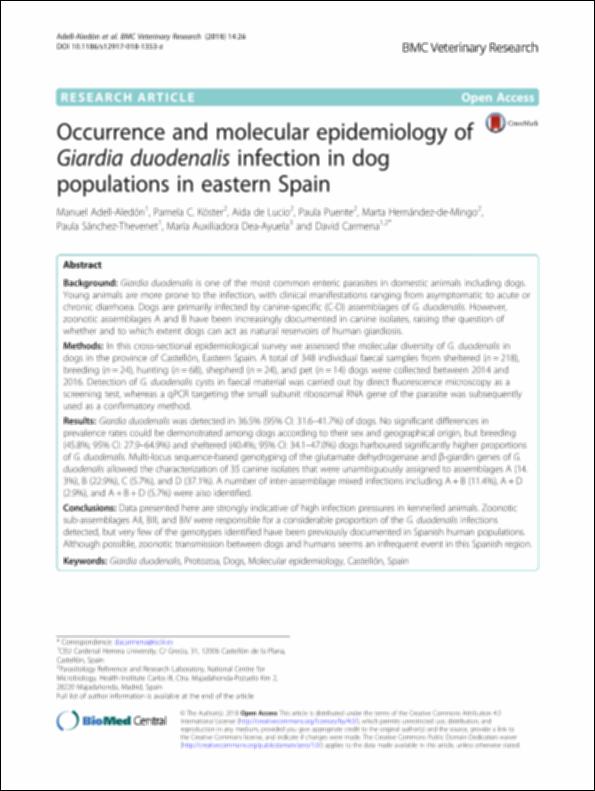Por favor, use este identificador para citar o enlazar este ítem:
http://hdl.handle.net/10637/9986Occurrence and molecular epidemiology of "Giardia duodenalis" infection in dog populations in eastern Spain
| Título : | Occurrence and molecular epidemiology of "Giardia duodenalis" infection in dog populations in eastern Spain |
| Autor : | Adell Aledón, Manuel Köster, Pamela C. Lucio, Aida de Puente, Paula Hernández de Mingo, Marta Sánchez Thevenet, Paula Dea Ayuela, María Auxiliadora Carmena Jiménez, David Antón |
| Materias: | Epizootiología.; Giardiasis - Spain - Valencia (Autonomous Community) - Castellon (County); Lambliasis - España - Comunidad Valenciana - Castellón (Provincia); Protozoos.; Giardia lamblia.; Protozoa.; Veterinary epidemiology.; Perros - Enfermedades parasitarias - España - Comunidad Valenciana - Castellón (Provincia); Dogs - Parasitic diseases - Spain - Valencia (Autonomous Community) - Castellon (County) |
| Editorial : | BioMed Central. |
| Citación : | Adell-Aledon, M., Koster, PC., de Lucio, A., Puente, P., Hernandez-de-Mingo, M., Sanchez-Thevenet, P., Dea-Ayuela, MA. and Carmena, D. (2018). Occurrence and molecular epidemiology of Giardia duodenalis infection in dog populations in eastern Spain. BMC Veterinary Research, vol. 14, art. 26. DOI: https://doi.org/10.1186/s12917-018-1353-z |
| Resumen : | Background: Giardia duodenalis is one of the most common enteric parasites in domestic animals including dogs. Young animals are more prone to the infection, with clinical manifestations ranging from asymptomatic to acute or chronic diarrhoea. Dogs are primarily infected by canine-specific (C-D) assemblages of G. duodenalis. However, zoonotic assemblages A and B have been increasingly documented in canine isolates, raising the question of whether and to which extent dogs can act as natural reservoirs of human giardiosis. Methods: In this cross-sectional epidemiological survey we assessed the molecular diversity of G. duodenalis in dogs in the province of Castellón, Eastern Spain. A total of 348 individual faecal samples from sheltered (n = 218), breeding (n = 24), hunting (n = 68), shepherd (n = 24), and pet (n = 14) dogs were collected between 2014 and 2016. Detection of G. duodenalis cysts in faecal material was carried out by direct fluorescence microscopy as a screening test, whereas a qPCR targeting the small subunit ribosomal RNA gene of the parasite was subsequently used as a confirmatory method. Results: Giardia duodenalis was detected in 36.5% (95% CI: 31.6–41.7%) of dogs. No significant differences in prevalence rates could be demonstrated among dogs according to their sex and geographical origin, but breeding (45.8%; 95% CI: 27.9–64.9%) and sheltered (40.4%; 95% CI: 34.1–47.0%) dogs harboured significantly higher proportions of G. duodenalis. Multi-locus sequence-based genotyping of the glutamate dehydrogenase and β-giardin genes of G. duodenalis allowed the characterization of 35 canine isolates that were unambiguously assigned to assemblages A (14.3%), B (22.9%), C (5.7%), and D (37.1%). A number of inter-assemblage mixed infections including A + B (11.4%), A + D (2.9%), and A + B + D (5.7%) were also identified. Conclusions: Data presented here are strongly indicative of high infection pressures in kennelled animals. Zoonotic sub-assemblages AII, BIII, and BIV were responsible for a considerable proportion of the G. duodenalis infections detected, but very few of the genotypes identified have been previously documented in Spanish human populations. Although possible, zoonotic transmission between dogs and humans seems an infrequent event in this Spanish region. |
| Descripción : | Este artículo se encuentra disponible en la página web de la revista en la siguiente URL: https://bmcvetres.biomedcentral.com/articles/10.1186/s12917-018-1353-z |
| URI : | http://hdl.handle.net/10637/9986 |
| Derechos: | http://creativecommons.org/licenses/by/4.0/deed.es |
| ISSN : | 1746-6148. |
| Fecha de publicación : | 16-ene-2018 |
| Centro : | Universidad Cardenal Herrera-CEU |
| Aparece en las colecciones: | Dpto. Medicina y Cirugía |
Los ítems de DSpace están protegidos por copyright, con todos los derechos reservados, a menos que se indique lo contrario.


